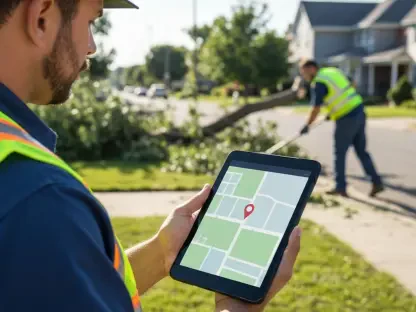Imagine walking into a store, standing in front of a sleek, high-tech mirror, and instantly seeing yourself in dozens of outfits without ever stepping into a dressing room, a reality now made possible by augmented reality (AR) mirrors that are transforming the retail landscape. With projections estimating the AR market in retail to skyrocket from its current value to a staggering $76.55 billion by 2032, the industry is on the cusp of a monumental shift. These innovative mirrors are not just changing how customers shop but are also redefining business operations with enhanced engagement and significant cost savings. From flagship stores to broader applications, AR mirrors are proving to be more than a novelty—they’re a strategic tool for retailers aiming to stay ahead in a digital-first world. This technology is capturing attention with its ability to merge the physical and virtual, setting a new standard for shopping experiences.
Redefining the Shopping Experience with AR Technology
The integration of AR mirrors into retail spaces is creating a seismic shift in how consumers interact with products, offering a seamless blend of convenience and personalization. Take the example of Bershka’s flagship store at Manchester’s Trafford Centre, where shoppers can virtually try on clothing using Snapchat filters, share their looks on social media, and bypass traditional fitting rooms. This immersive experience caters to a generation that values speed and digital connectivity, making shopping feel more like entertainment than a chore. Beyond just trying on clothes, these mirrors provide real-time styling suggestions and product information, enhancing decision-making without the hassle of physical changes. The result is a captivating, interactive process that keeps customers engaged longer, fostering brand loyalty in an era where attention spans are fleeting. Retailers adopting this technology are not merely keeping up with trends but are actively shaping the future of consumer expectations.
Statistics further illuminate the transformative power of AR mirrors in retail, underscoring their impact on customer behavior and business outcomes. Research shows that retailers employing virtual try-on solutions witness a remarkable 200% increase in conversion rates, as shoppers are more confident in their purchases when they can visualize outcomes instantly. Additionally, product returns drop by 25%, saving significant costs in logistics and inventory management. A striking 71% of consumers report they would shop more frequently with stores offering AR-powered apps, while 40% are willing to pay a premium for products they can test virtually. These numbers highlight a clear shift—shoppers are not just intrigued by the novelty but are driven by the practical benefits of seeing exactly what they’re buying. As hardware improves and costs decline, the adoption of AR mirrors is becoming a no-brainer for retailers looking to boost sales and streamline operations in a competitive market.
Industry Adoption and Broader Market Trends
Major retailers are racing to integrate AR mirrors, recognizing them as a cornerstone of modern retail strategy, with adoption spanning beyond niche experiments to mainstream implementation. Companies like H&M, Burberry, Zalando, and Fendi are rolling out variations of this technology, from virtual clothing lines in the metaverse to 3D product visualizations that let customers preview items in intricate detail. Zalando’s “Try On” feature, for instance, has already engaged 30,000 users, demonstrating the scalability of such innovations. This widespread embrace reflects a broader industry trend toward digital integration, particularly as Generation Z—digital natives now hitting peak spending power—demands tech-savvy shopping experiences. The timing couldn’t be more apt, with advancements like 4K real-time rendering making virtual try-ons more realistic than ever. Retailers are finding that AR mirrors align perfectly with evolving consumer habits shaped by post-pandemic preferences for contactless and interactive solutions.
The financial case for AR mirrors is equally compelling, painting a picture of substantial returns on investment that few technologies can match. For a retailer generating $100 million in annual sales, implementing this technology could save between $5 million and $7.5 million yearly in return processing costs alone. This is a game-changer in an industry where margins are often razor-thin, and operational efficiency is paramount. Moreover, Snapchat research reveals that AR experiences are 82% more likely to be recommended by users, hinting at a viral growth potential that could amplify brand reach organically. As the market for AR in retail is projected to grow exponentially over the next several years, the technology is poised to become a standard rather than an exception. Retailers who hesitate risk falling behind competitors who are already capitalizing on this quiet revolution, proving that AR mirrors are not just a flashy add-on but a critical component of future-proofing business models.
Expanding Horizons Beyond Retail
The versatility of AR mirrors extends far beyond fashion retail, opening doors to innovative applications across a diverse array of industries. In automotive showrooms, for example, customers can visualize custom car features like paint colors or interior upgrades without the need for physical inventory, streamlining the sales process. Real estate agents are leveraging similar technology to showcase furniture layouts in empty properties, helping buyers envision their dream homes. Even healthcare is tapping into this potential, with telemedicine platforms using AR mirrors to allow patients to display symptoms remotely for more accurate diagnoses. These cross-sector implementations highlight the adaptability of AR technology, proving that its value lies in enhancing customer interaction and decision-making, no matter the field. As more industries experiment with these tools, the scope of AR mirrors continues to expand, promising a future where virtual visualization becomes a universal standard.
Further applications in hospitality, beauty, and manufacturing underscore the far-reaching implications of AR mirrors as a transformative force. Hotels could offer virtual styling sessions for guests preparing for events, while beauty salons might use mirrors for clients to preview hairstyles or makeup looks before committing. In B2B manufacturing, AR technology enables simulations for machinery placement, optimizing factory layouts without costly physical trials. Each of these use cases demonstrates a unique benefit—reducing uncertainty for consumers and cutting overhead for businesses. The ripple effect of such innovations suggests that what began as a retail experiment could redefine operational norms across sectors. With market growth projections soaring, the influence of AR mirrors is set to permeate industries that once seemed unrelated, illustrating a technological convergence that prioritizes efficiency and engagement above all else.
Reflecting on a Digital Transformation
Looking back, the journey of AR mirrors marks a pivotal chapter in retail history, evolving from clunky, impractical interfaces to polished, indispensable tools that have reshaped consumer experiences. Their ability to drive a 200% surge in conversions and slash return rates by 25% underscores a profound impact on profitability and satisfaction. As adoption spreads from pioneering stores in Manchester to global giants, the technology’s promise has crystallized into measurable success. For those in the industry, the next steps involve scaling these solutions, refining hardware for even greater realism, and exploring untapped sectors hungry for digital innovation. Retailers and beyond are tasked with staying agile, integrating AR mirrors not as a luxury but as a necessity to meet modern demands. The quiet revolution that started with a single store reflects a broader shift, urging businesses to invest now or risk being left behind in a rapidly evolving landscape.









